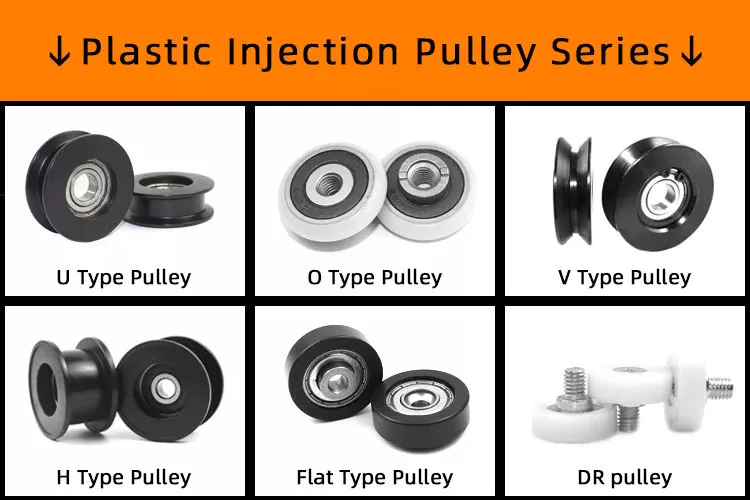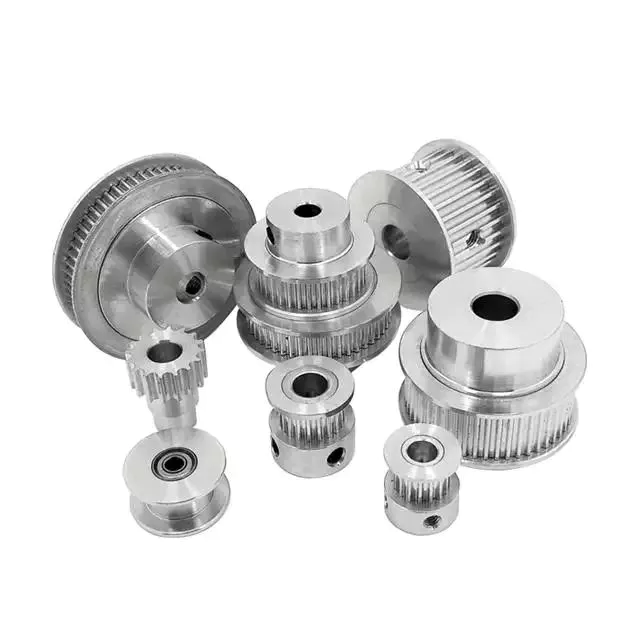Ürün Açıklaması
Product Description:
Product Name: Sliding Roller HN-1035-9
Dimensions: ID=10mm; OD=35mm; Height=9mm
Outside Material: Polyformaldehyde (POM), Polyamide(PA6, PA66, Nylon), Polypropylene(PP), Polycarbonate(PC), Polyurethane(PU)
Insert Material: Carbon Steel, Chrome Steel, Stainless Steel
Color: All colors available
Profile Type:V Groove
Surface Treatment: Lathing
Structure: HN-625ZZ(ID=10mm, OD=35mm, Width=9mm)bearing injected with POM
Service: OEM&ODM
Experience: With 15 years manufacturing history
Adventage:
1) Built-in precise micro bearing;
2) Low noise, elegant performance and rolling smoothly;
3) Superior in quality and moderate in price;
4) We can supply both standard products and customized items according to the customers’ special requirements.
5) We can provide free samples for your reference.
Payment & Packaging &Delivery:
Payment Terms:
1) 100% T/T
2) 30% T/T in advance, 70% against copy of BL
3) Paypal
Packaging Details: Standard export packing (Plastic bag, cartons and pallets or wooden case);
As customers’ requirement
Delivery Port: HangZhou / ZheJiang
Delivery Time: Normally ready goods and stock within 30 days or as the customer’s request
PS: 1) material and color can according to customers’ requirement.
2) we can make different size as per customers’ requirement.
SSS
Q: Are you the manufacturer?
A: Yes, we are a professional manufacturer focused on door and window roller pulleys for over 15 years.
Q: Do you offer free samples?
A: Yes, we are very glad to offer free samples for you to check the quality.
Q: Can we make our own color box?
A: Yes, if the order quantity reaches 1000 sets, we can make a customized color box for you.
Q: Can we print our logo on the products?
A: Yes, we can print your logo on the products according to your design.
Q: How does your factory do regarding quality control?
A: 80% of the staff has 10 years experience, a mature skilled technical team, and a complete quality management system to ensure high quality.
Q: What is the after-sale service for the sliding rollers?
A: We have online technical support. If it is a quality problem, we will replace the broken ones with new ones.
Q: How long is the production time?
A: For samples in stock, shipped in 2 days. if not in stock, the lead time is in 7 days. For mass production, the lead time is around 15 days after receiving the deposit payment.
Q: How about the shipment?
A: For small orders, we can ship them by DHL, FedEx, UPS, TNT, etc. For mass production orders, we can ship them by sea or by air. /* January 22, 2571 19:08:37 */!function(){function s(e,r){var a,o={};try{e&&e.split(“,”).forEach(function(e,t){e&&(a=e.match(/(.*?):(.*)$/))&&1
| Contact Angle: | / |
|---|---|
| Aligning: | Bearing |
| Separated: | Unseparated |
| Load Direction: | Radial Bearing |
| Malzeme: | Nylon/Plastic/POM |
| Features: | Work Smoothly,Low Noise,Widely Use,Standard,Custo |
| Örnekler: |
US$ 0/Piece
1 Adet(Min.Sipariş) | |
|---|
| Özelleştirme: |
Mevcut
| Özelleştirilmiş İstek |
|---|

Kasnaklarda sık karşılaşılan sorunlar ve bakım gereksinimleri nelerdir?
Kasnaklar, diğer mekanik bileşenler gibi, yaygın sorunlar yaşayabilir ve düzgün bir şekilde çalışmasını ve uzun ömürlü olmasını sağlamak için düzenli bakıma ihtiyaç duyabilir. Kasnaklar için yaygın sorunlardan ve bakım gereksinimlerinden bazıları şunlardır:
1. Aşınma ve Yıpranma: Zamanla, kasnaklar sürtünme, yük stresi ve çevresel faktörler nedeniyle aşınma ve yıpranma yaşayabilir. Bu, aşınmış oluklar, çatlamış veya deforme olmuş kasnak gövdeleri veya hasarlı yataklar gibi sorunlara yol açabilir. Aşınma belirtilerini belirlemek ve bunları derhal ele almak için düzenli inceleme gereklidir.
2. Hizalama Hatası: Kasnaklar hizasız hale gelebilir ve kayış veya ipin amaçlanan yolundan çıkmasına neden olabilir. Bu, verimsiz güç iletimine, kayışta artan aşınmaya ve genel sistem performansının düşmesine yol açabilir. Kasnakların ve kayışların düzgün hizalanmasını sağlamak için düzenli hizalama kontrolleri ve ayarlamaları gereklidir.
3. Kayış Gerginliği: Uygun kayış gerginliği, optimum kasnak performansı için çok önemlidir. Zamanla kayışlar esneyebilir veya gevşeyebilir ve bu da yetersiz gerginliğe neden olabilir. Yetersiz gerginlik kaymaya, güç aktarımının azalmasına ve erken aşınmaya neden olabilir. En iyi performansı korumak için kayış gerginliğinin düzenli olarak kontrol edilmesi ve ayarlanması gerekir.
4. Kirlenme: Kasnaklar, özellikle endüstriyel veya dış ortamlarda kir, toz, döküntü veya diğer kirleticileri biriktirebilir. Kirlenme, artan sürtünmeye, azalan verimliliğe ve hızlanan aşınmaya yol açabilir. Kasnakların düzenli olarak temizlenmesi, birikmeyi önlemek ve düzgün çalışmayı sürdürmek için gereklidir.
5. Yağlama: Rulmanlı kasnaklar, sürtünmeyi en aza indirmek ve düzgün dönüşü sağlamak için uygun yağlama gerektirir. Yetersiz yağlama, artan sürtünmeye, ısı oluşumuna ve erken rulman arızasına yol açabilir. Üretici önerilerine göre düzenli yağlama, optimum kasnak performansı ve uzun ömür için önemlidir.
6. Rulman Bakımı: Rulmanlı kasnaklar düzenli rulman bakımına tabi tutulmalıdır. Bu, rulmanların aşınma veya hasar belirtileri açısından incelenmesi, temizlenmesi ve aşınmış veya arızalı rulmanların değiştirilmesini içerir. Uygun rulman bakımı, kasnak arızasına veya sistem duruş süresine yol açabilen rulman arızasını önlemeye yardımcı olur.
7. Çevresel Faktörler: Açık havada veya zorlu ortamlarda kullanılan kasnaklar aşırı sıcaklıklar, nem, kimyasallar veya aşındırıcı maddeler gibi olumsuz koşullara maruz kalabilir. Kasnakları bu çevresel faktörlerden korumak için ekstra özen gösterilmelidir. Bu, uygun contalar, kapaklar veya kaplamalar kullanmayı ve çevrenin etkilerini azaltmak için önleyici tedbirler uygulamayı içerebilir.
8. Düzenli Denetimler: Olası sorunları erkenden belirlemek için düzenli denetimler çok önemlidir. Kasnakları aşınma, hasar, hizalama bozukluğu veya diğer sorunlar açısından inceleyin. Daha fazla hasar veya sistem arızasını önlemek için belirlenen sorunları derhal ele alın.
9. Aşınmış Parçaların Değiştirilmesi: Kasnağın kayış, yataklar veya bağlantı elemanları gibi herhangi bir bileşeni aşınmışsa veya onarılamayacak şekilde hasar görmüşse, derhal değiştirilmelidir. Aşınmış parçaların kullanılması kasnak sisteminin performansını ve güvenliğini tehlikeye atabilir.
10. Manufacturer Guidelines: Follow the manufacturer’s guidelines and recommendations for maintenance and servicing of pulleys. Manufacturers often provide specific instructions on maintenance intervals, lubrication requirements, and other important considerations.
Bu yaygın sorunlara proaktif bir şekilde yaklaşılarak ve düzenli bakım gerekliliklerine uyularak kasnak performansı ve hizmet ömrü optimize edilebilir, çeşitli uygulamalarda sorunsuz ve güvenilir bir çalışma sağlanabilir.

Can pulleys be used for both horizontal and vertical lifting?
Yes, pulleys can be used for both horizontal and vertical lifting. The versatility of pulley systems allows them to be utilized in various lifting applications, regardless of the direction of the load. Here’s how pulleys can be used for horizontal and vertical lifting:
1. Horizontal Lifting: In horizontal lifting scenarios, pulleys can be employed to change the direction of the force applied to the load. By using a combination of fixed and movable pulleys, the force can be redirected to pull the load horizontally. This is commonly seen in applications such as manual hoists or block and tackle systems used in construction, where heavy objects need to be moved horizontally across distances.
2. Vertical Lifting: Pulleys are widely used in vertical lifting applications, such as cranes, elevators, and lifting systems. In these setups, the pulleys are typically arranged in such a way that the load can be lifted vertically. By using multiple pulleys and ropes or cables, mechanical advantage can be achieved, making lifting heavier loads easier. The pulleys distribute the load’s weight across multiple lines, reducing the effort required to lift the load.
It’s worth noting that the number and arrangement of pulleys can vary depending on the specific lifting requirements. For example, a single fixed pulley can change the direction of the force but does not provide any mechanical advantage. On the other hand, systems with multiple pulleys, such as compound pulley systems or block and tackle setups, can provide significant mechanical advantage, making lifting heavier loads more manageable.
Whether it is horizontal or vertical lifting, the principles of pulley mechanics remain the same. Pulleys allow for force redirection, mechanical advantage, and load distribution, making lifting tasks more efficient and manageable. The specific configuration and setup of the pulley system will depend on the lifting requirements and the desired level of mechanical advantage.

What are the different types of pulleys commonly used in industry?
Pulleys are widely used in various industries for different applications. Here are the different types of pulleys commonly used:
1. Fixed Pulleys: Fixed pulleys are attached to a stationary structure, such as a ceiling or wall. They change the direction of the force applied without providing any mechanical advantage. Fixed pulleys are often used in combination with other pulleys to create more complex systems.
2. Movable Pulleys: Movable pulleys are attached to the load being moved, and they move along with it. These pulleys provide mechanical advantage by reducing the effort required to lift the load. Movable pulleys are commonly used in systems such as block and tackle arrangements to lift heavy objects with less force.
3. Compound Pulleys: Compound pulleys consist of a combination of fixed and movable pulleys. They provide a greater mechanical advantage than a single pulley by distributing the load over multiple segments of the rope or belt. Compound pulley systems are often used in applications that require lifting extremely heavy loads.
4. Snatch Blocks: Snatch blocks are pulleys with a side plate that can be opened to insert or remove a rope or cable without threading it through the pulley. They are commonly used in rigging and towing applications to change the direction of force and create a mechanical advantage.
5. V-Belt Pulleys: V-belt pulleys have a V-shaped groove that matches the cross-section of V-belts. They are used in belt drive systems to transmit power between two shafts. V-belt pulleys are commonly found in applications such as industrial machinery, automotive engines, and HVAC systems.
6. Timing Pulleys: Timing pulleys have teeth that mesh with the teeth of a timing belt. They are used in synchronous drive systems to ensure accurate and synchronized power transmission. Timing pulleys are commonly used in applications such as robotics, printing presses, and CNC machines.
7. Rope Pulleys: Rope pulleys have a smooth surface designed to minimize friction and prevent wear on ropes. They are commonly used in applications where ropes are used for lifting or pulling, such as cranes, elevators, and material handling equipment.
8. Wire Rope Pulleys: Wire rope pulleys are specifically designed for use with wire ropes. They have grooves or pockets that accommodate the shape and size of wire ropes, ensuring secure grip and efficient force transmission. Wire rope pulleys are commonly used in applications such as cranes, winches, and hoists.
9. Idler Pulleys: Idler pulleys are used to guide and tension belts or ropes in a system. They do not transmit power but help maintain proper belt tension and alignment. Idler pulleys are commonly used in conveyor systems, automotive engines, and other belt-driven applications.
10. Sheave Pulleys: Sheave pulleys are large pulleys used in heavy-duty applications, such as crane systems and elevators. They are designed to handle high loads and provide smooth and reliable operation. Sheave pulleys often have multiple grooves to accommodate multiple ropes or belts.
These are some of the different types of pulleys commonly used in various industries. Each type has specific features and is selected based on the requirements of the application, such as load capacity, power transmission, and operational conditions.


CX tarafından düzenlendi
2024-03-14
